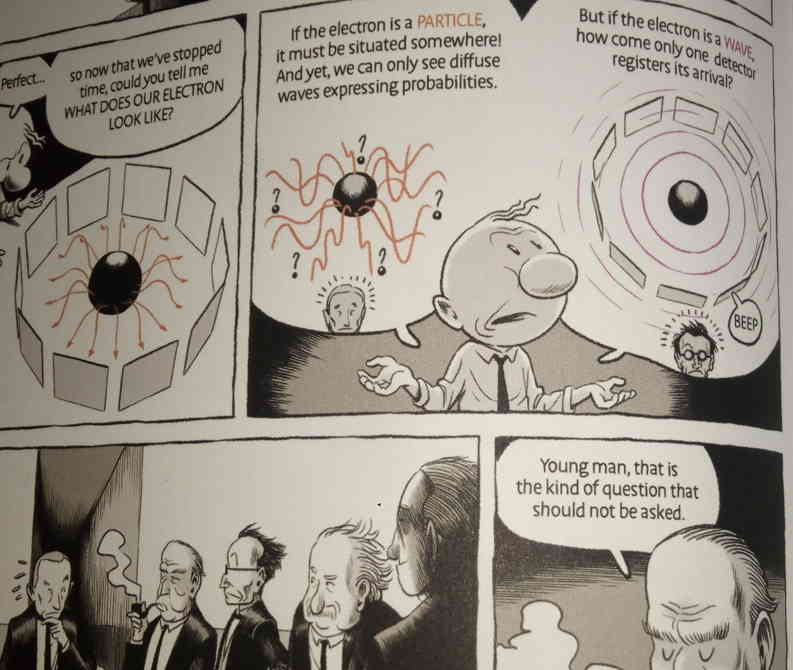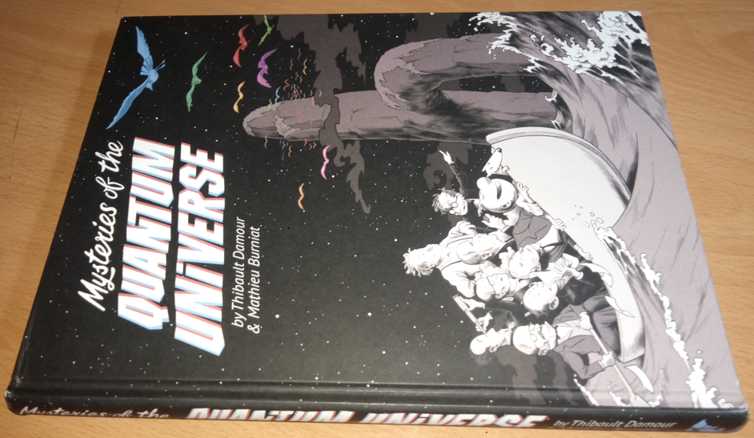As I wrote in the post about Logicomix, I wanted to see what result can be achieved using a medium like comics to present and explain scientific concepts.
So I tried it with another book: “Mysteries of the Quantum Universe” by the theoretical physicist Thibault Damour and the author of graphic novels Mathieu Burniat.
After a quick first reading I had a positive impression, although I thought it was aimed at readers with no – or very basic – knowledge of quantum physics. You have a good time, it’s nice graphically, but you don’t learn anything new if you’ve already read a little about this subject.
Note: I have just begun to read “Understanding Comics” by Scott McCloud (1993), a reference for understanding the codes of this medium. I hope to do a more thorough analysis in the next comics I read.
Then I read it again to provide a more detailed comments. Here they are, divided into pros and cons from my point of view:
I liked:
- Explain concepts based on the graphic component. I mean that sometimes the drawings really help to understand the text and are not mere illustrations without special meaning.
There were more than I remembered from the first quick reading, maybe I was only impressed by the most originals. I will mention:- The quantization of the energy proposed by Planck, the oscillator model and the distribution of energy
- The moment exchange between quanta of light and atoms
- The model of atomic levels/orbitals
- Representation of states with complex numbers using colored circle
- Probabilities associated with wave function
- The superposition of states (and the multiplicity of worlds)
- The rigour of the content, in spite of the limitations that the medium ‘imposes’ that do not allow to enter into sufficient nuances and details.
- A selective use of colour to highlight certain aspects in illustrations and texts that works very well.
- Introduce some topics not usually seen in quantum mechanics basic level books (e.g. Einstein’s transitions probabilities).

I liked it less:
- What looks like filler pages, especially in the transitions between scenarios and characters. It is logical that there are vignettes with this function so that the story flows with a proper rhythm without overwhelming us with explanations, but in some cases they reach up to four pages; I see it excessive and using almost repeated effects.
- Not trying to extend or improve the explanations of some concepts. An example (there are some more for me): Schrödinger’s equation, where I miss a description with a qualitative idea of the terms.
- Wave behavior is well described in the double-slit experiment, but the corpuscular one is not mentioned (when we try to detect the particle’s path). This is discussed later in the electron-atom collision, but I think this experiment is so fundamental in quantum physics that it would have been better to present it completely.
- It could seems that the ‘Many Worlds’ interpretation of quantum mechanics is the correct one –as an alternative to Copenhagen’s interpretation– in the way it is presented (it’s true that the author doesn’t say that, as he explains in Everett’s entry in the appendix). It would have been nice to mention other alternative interpretations (Bohm,…)
Other issues can be more ‘neutral’ and I see them more or less positive depending on the point of view I take. Here are two examples:
- There are difficult subjects to explain at this level and even more in a comic, such as Heisenberg’s matrices. The author might want to convey that they are abstract concepts far away from our everyday experience, but a clearer explanation could have been tried.
- The text-only appendix with further information. It may be fine as a complement, but its treatment is of a higher level and some topics are not even mentioned in the comic.
When I finished my comments on the book I found the Brian Clegg’s review on the Internet. Although I enjoyed the comic a bit more than he did I subscribe lot of what he says (well, perhaps his problem with ink smell is a bit excessive ? ).
In short, for me it’s not a perfect book but it has some very positive aspects (possibly we all have our part of reason to praise or criticize it) and above all, as Clegg also concludes, I applaud this initiative and hope that more comics will continue to appear that explore this medium to spread the knowledge of science.
Finally, I insert the video where the authors present the book. It’s in French, and though it’s not attractive (from a marketing point of view), it can give a better idea of the work.

Comments